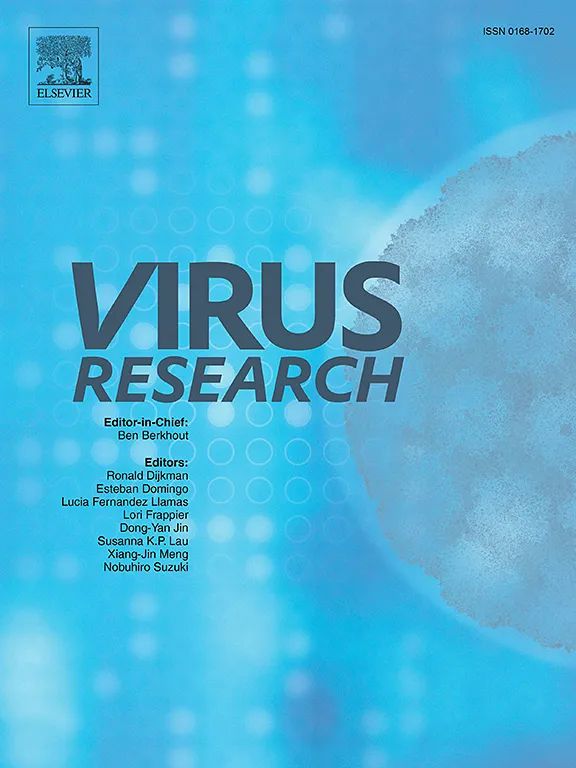Pathogenicity of avian reovirus variant in the immune organs of broiler chicks
IF 2.7
4区 医学
Q3 VIROLOGY
引用次数: 0
Abstract
In recent years, the infection rate of avian reovirus (ARV) in chicks has been continuously increasing, seriously endangering the healthy development of China's chicken farming industry. However, the pathogenicity of this virus in immune organs has been less studied. In this study, an ARV strain (Chicken/XJ/China/2022/01/16) was isolated from arthritic broiler chicks in Xinjiang province and whole genome sequencing of the ARV strain was performed using next generation sequencing (NGS) technology, and sequence analysis showed that the strain was a type V variant of the ARV gene. In order to further understand the pathogenicity of this strain in terms of immune organs, we randomized 120 healthy 1-day-old broilers equally into 3 groups (oral, footpad inoculation and control), where 2 experimental groups were inoculated with 0.2 mL of ARV (TCID50 of 105.5 /0.1 mL) and the control group was inoculated with an equal amount of sterile saline. The results showed that the footpad inoculation group showed more severe symptoms, which, in addition to causing chick dwarf syndrome and viral arthritis, would also cause serious effects on the immune organs of the chicks. Among them, the spleen and bursa were most seriously damaged, the symptoms of arthritis appeared relatively late, which indicated that the spleen and bursa might be the main target organs preferentially attacked by avian reovirus. This study provides a rationale for the prevention and control of emerging avian reovirus and adds to the evidence of the effects of ARV on immune organs, with the expectation that it will be useful in understanding the immune response-related aspects of the disease in subsequent studies.
禽呼肠孤病毒变异对肉鸡免疫器官的致病性。
近年来,禽类呼肠孤病毒(ARV)在雏鸡中的感染率不断上升,严重危及中国养鸡业的健康发展。然而,该病毒在免疫器官中的致病性研究较少。本研究从新疆省关节炎肉鸡中分离到一株ARV毒株(Chicken/XJ/China/2022/01/16),采用下一代测序(NGS)技术对该毒株进行全基因组测序,序列分析表明该毒株为ARV基因的V型变异。为了进一步了解该菌株在免疫器官方面的致病性,我们将120只1日龄健康肉鸡随机分为3组(口服、脚底接种和对照组),其中2个试验组接种0.2 mL ARV (TCID50为105.5 /0.1 mL),对照组接种等量无菌生理盐水。结果表明,脚垫接种组症状更为严重,除引起雏鸡侏儒综合征和病毒性关节炎外,还会对雏鸡免疫器官造成严重影响。其中脾脏和法氏囊损伤最严重,关节炎症状出现较晚,提示脾脏和法氏囊可能是禽呼肠孤病毒优先攻击的主要靶器官。这项研究为预防和控制新出现的禽呼肠孤病毒提供了理论依据,并为抗逆转录病毒药物对免疫器官的影响提供了更多证据,预计它将有助于在随后的研究中了解该疾病的免疫反应相关方面。
本文章由计算机程序翻译,如有差异,请以英文原文为准。
求助全文
约1分钟内获得全文
求助全文
来源期刊

Virus research
医学-病毒学
CiteScore
9.50
自引率
2.00%
发文量
239
审稿时长
43 days
期刊介绍:
Virus Research provides a means of fast publication for original papers on fundamental research in virology. Contributions on new developments concerning virus structure, replication, pathogenesis and evolution are encouraged. These include reports describing virus morphology, the function and antigenic analysis of virus structural components, virus genome structure and expression, analysis on virus replication processes, virus evolution in connection with antiviral interventions, effects of viruses on their host cells, particularly on the immune system, and the pathogenesis of virus infections, including oncogene activation and transduction.
 求助内容:
求助内容: 应助结果提醒方式:
应助结果提醒方式:


